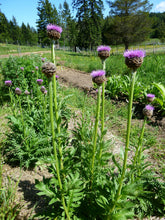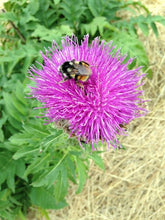(Approx. 30 seeds/pkt)
Though relatively unknown in North America, maral root has long been used in Russia, China, Mongolia and eastern Europe for physical strength and endurance. Athletes use it to enhance sports performance.
The powerful benefits of maral root became apparent long ago when Siberian hunters observed maral deer stags digging and eating the roots during mating season.
Recent scientific research is revealing that maral root stimulates mental as well as physical sharpness and fortitude. It provides relief from overstrained muscles, fatigue from overwork and weakness from illness. It has become an effective medicine in the treatment of impotence and erectile dysfunction. As well, it helps people who suffer from anxiety depression and alcohol addiction. It won’t be long before maral root powders and tinctures will found in health food stores across Canada and the US.
In some of the coldest regions of Central Asia, maral root has been used not only to fight colds, coughs and sore throat but also for endurance against extremely frigid weather.
Maral root is high in antioxidants and also contains ecdysteroids that help regulate protein synthesis in a way similar to steroids but without their harmful effects. They promote lean muscle growth while reducing body fat. In herbal lore, maral root is termed an adaptogen because it increases the body’s ability to withstand stress. It can increase blood pressure over time, so it’s best to avoid long-term use.
Also called Russian Leuzea, it is a very long-lived perennial. (Some sources say it can live from 75-150 years!) Leaves are deeply incised and pointed. In the spring of its second year, large solitary, thistle-like, magenta blossoms top 2-foot thick round stems. One of the earliest spring flowers, they are loved by bees and have a wonderful vanilla-like fragrance. Maral root would be a very ornamental addition to flower gardens as well as to medicinal herb gardens.
Maral root seeds are typically listed as requiring cold treatment but we find that they are easily germinated indoors at cool temperatures: sow about 1/8" deep in moist soil, keep soil moist at 50F-65F and seeds will germinate within a week or two.




